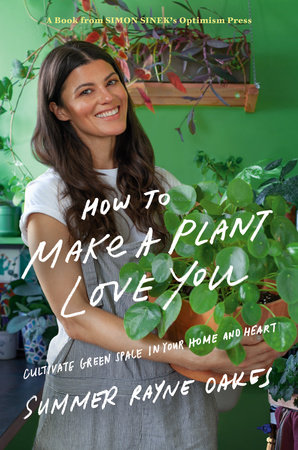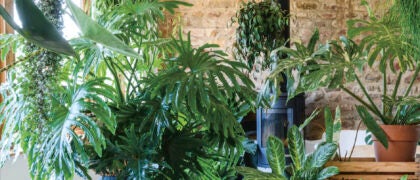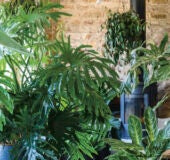HOW TO MAKE A PLANT LOVE YOUChapter 1The Mass Migration"You didn’t come into this world. You came out of it, like a wave from the ocean. You are not a stranger here."
—Alan Watts
“Plants are beautiful and unique. They grow the way they want, without any pressure to grow the way someone else wants them to grow. I use my plants to see life more clearly. To understand that it can be simple.”
—Sarah Solange
It was preposterous to think I’d ever live in a city. All that concrete and glass piled on top of one another, the loud noises, the starless sky. I bet the frogs I put carefully in buckets to bring home as a kid would never have guessed that I would ever leave the countryside, either.
I padded down the forest path, my feet light and quick. I had read somewhere, or maybe I heard it from a childhood friend, that Native Americans who had lived and hunted in Pennsylvania were so silent that when they ran in the woods, they could barely be detected by animal or enemy. I marveled at that idea. And aspired to be as silent.
It was easier to travel quietly in the morning, after a heavy dew, or just after a rain. The sounds of the forest floor were dampened then, and that’s often when birdsong would be at its highest. I whooshed past the hemlocks, inhaling their lemony pine scent. Wet ferns tickled my shins with their feather touch. The forest floor glinted with emerald mats of mosses and the waxy, evergreen leaves of creepers: partridgeberry (
Mitchella repens) and wintergreen (
Gaultheria procumbens). Once in a while something would catch my eye that required a closer inspection: a flower I hadn’t noticed before, a dew-laden insect creeping along the underside of a leaf, or a bright-orange jelly fungus oozing from the wound of a fallen tree branch. I’d collect it if I wanted to continue studying it. Then I would clamber over the stone wall that bridled the forest from our freshly mowed lawn.
I would often press plants between books, arrange them in indoor mini-habitats akin to dioramas, and commandeer parts of the refrigerator for my science experiments. Before I turned five, I absconded with my brother’s never-used birthday present—a beautifully designed, German-made microscope, which came equipped with captivating glass slides mounted with thinly sliced onion skins, moss-leaf cells, and diatoms and a box of empty slides that I could make myself. I put it to good use for nearly a decade of my childhood. Even today I lust for a well-made microscope, as it’s a superb way to bring us closer to nature—literally and figuratively.
I learned to love the forest and everything in it. So much so that it was often challenging for my parents to get me to come home. In my teenage years, I was content to spend most of every summer day in the woods, rarely seeing my school friends. But I never once felt alone.
In addition to learning to love the wildness of nature, I grew up seeing the beautiful communion that can happen when humans and plants cooperate. Outside the forest, my mother prided herself on the upkeep of her immaculate flower gardens. Bright yellow forsythias (
Forsythia × intermedia), which shone like sunbeams in spring, bordered our land; double-flowered hollyhocks (
Alcea sp.) in whites, pinks, and wines stood as erect as the Queen’s Guard out of the rockiest of soils; gaily dressed tulips (
Tulipa sp.) and daylilies (
Hemerocallis sp.)—in the colors of an African sunset—were impressively plentiful; the musky scent of marigolds (
Tagetes sp.) and Queen Anne’s lace (
Daucus carota) would be all too apparent if you cared to bend down to weed; and the smell of hyacinths, lilacs, and pillow-soft peonies (
Hyacinthus sp., Syringa sp., Paeonia sp.) the size of pink cabbages filled the air and coated the back of your throat with the most intoxicating perfumes.
The vegetable garden and orchard, tended by both my mother and father, were equally impressive. At just a half an acre, the land had enough delights to please the senses, like the pucker-your-face tartness of rhubarb stalks (
Rheum rhabarbarum) and shiny redcurrants (
Ribes rubrum), which my mother would make pies and crepes with, respectively. Or how could I forget my favorite foraged flavor—the gooseberry (
Ribes hirtellum), whose russet-colored flesh and pectinous bite were like eating a sweet-but-tart grape? It was within this cultivated space that I learned the lessons of patience, respect, and trust in the internal clocks of living things. Plants thrive when provided with the conditions to reach their potential in their own time. In the beginning of the season, we would transport pungent composted cow dung from my aunt’s farm next door and generously spread it over the land until it was nearly shin deep. The strawberries, squash, cucumbers, asparagus, lettuce, melons, peas, beans, and tomatoes loved it, and we always had far more fruits and vegetables during the growing season than our family of four could eat. There was always the fun of waiting for the next seasonal crop to burst forth, or wondering if the raspberries would be as plentiful this season the last. Anticipating their bounty seemed to heighten my curiosity in the plants we were growing.
Maybe the sweetness of anticipation is the reason I still eat seasonally as much as possible, often making a pilgrimage to my local greenmarket on Saturdays to purchase fresh fruits and vegetables for my weekly meals (and to drop off my composted food waste, produced from my previous week’s purchases). Somehow the intentionality of this ritual connects me to a timeline more far-reaching and unrushable than the twenty-four-hour clock we’re all caught up in.
Back home in my plant-filled apartment, I love preparing a meal among the ample leafage, which gives me a sense of “camping” indoors. Even in the winter months, when everything outside in the cold northeast seems gray and dour, most of my plants indoors still exhibit much vitality and life—even flaunting a rogue bloom here or there, which is always a treat. Last winter, my
Kleinia fulgens, also known as coral senecio or scarlet kleinia, pleasantly surprised me with a profusion of carmine-colored pom-poms, a starkly beautiful contrast against its subdued, gray-green leaves and the frosted windows behind. Once you start your plant pilgrimage, you may find that this affirmation of bud and bloom helps you savor the long-term relationship you’ve been developing with your plant, particularly after months of a little daily TLC.
My parents, speaking of TLC, were in the garden regularly—clearing the weeds, picking the zucchini, or cutting back the asparagus or garlic, two plants that seemed to spread spontaneously once established. I got the sense from my folks that there was much to do, but it wasn’t onerous. If anything, it was just as natural to be in the garden as it was to eat the fruits of our labor at the dinner table. In fact, the entire process seemed to be a joy. Hands in dirt was a way of life, and there was much to relish in those unembellished rituals.
The cultivation of flowers and veggies interested me, but I was most attracted to the wild plants strewn throughout the lawn and forest—and even as unwelcome migrants in the garden beds. They seemed to be the outsiders: unrestrained and unmanicured, prolific and unpretentious. They were all so different, packed tightly in and up against one another, yet they all seemed to cohabit unexpecedly well. In hindsight, it’s how I like my plants even when I bring them indoors—wild, unrestrained, a little unkempt, and surprisingly collaborative. They’ve taught me a great deal about how those who at first appear rowdy, pushy, and willful can be appreciated for their vitality, vigor, and persistence, if their nature is well understood and treated with kindness and caring boundaries.
I also learned, from poring over the thick, yellowing pages of my mother’s 1974 copy of
The Rodale Herb Book, that nearly all the plants around me could be used to heal, soothe, and nourish. Plants like coltsfoot (
Tussilago farfara), purslane (
Portulaca oleracea), and soapwort (
Saponaria officinalis) were no longer weeds to be pulled, but plants to be studied. I would play pharmacist, cook, and chemist—boiling coltsfoot leaves, noshing on purslane, and mashing up the leaves of the soapwort to release the bubbly saponins from which it gets its name. Even before there was fancy lab equipment to isolate plant alkaloids and scents, someone had taken notice; someone had observed and experimented with plants to uncover unique properties such as those. The secret healing and other potential powers of nature are there for the knowing. We just have to be willing to look for them.
It wasn’t easy to leave those beautiful woods, fields, orchards, and gardens. I moved to New York City to work. It’s where I envisioned experimenting with life and reaching my “fullest potential”—at least from a professional standpoint. And the work I’ve done here would have been far more difficult to attempt living back home in the country. I spent around fifteen years in the world of fashion, produced films, and engaged in the startup scene with my own businesses. Working with other creatives and entrepreneurs, living a fast-paced life in the city, I discovered that reaching one’s “fullest potential” often involves some trade-offs.
I remember hearing on a radio report as a kid in the nineties that in just a short period of time, more people on the planet would live in cities, outnumbering those residing in rural and suburban areas. Sure enough, about ten years ago, that prediction of mass migration became a reality: In the United States, nearly 81 percent of the general population now lives in urban areas, including me. And of the general population, 66 percent of us “Millennials”—or people born between 1980 and 2000, according to many psychologists—have flocked to cities and outlying metropolitan areas like winged insects feverishly encircling street lamps at dusk. As a result, for the first time since the 1920s, growth in US cities outpaces growth outside of them. And today, 55 percent of the world’s population considers urban centers home—a statistic projected to grow an additional 13 percentage points by 2050. This means that cities small and large are rapidly expanding, at least partially due to my own generation’s move to them.
Countless studies and opinions have already been circulated about Millennial trends. We live differently than previous generations. We’re more likely to delay marriage because we want to linger in the beatitude of singledom. We also delay mortgages—not because we don’t want to own our own homes, but largely because we can’t afford the expense, particularly if we’re eyeing the real estate in our beloved cities. But none of these trends explains our exodus from some of our more spacious, idyllic birthplaces.
My friends cite a few key reasons for their migrations: more people, more ideas, more innovations. In the city, you can create and reinvent yourself over and over again. It’s a pulsing human-centric ecosystem. Opportunities often come about by being in a place, meeting people, and putting yourself out there. Theoretically that happens more in cities because, like the charged electrons of the sun, we bump into each other more often. And you want more of these opportunities because when you come of the professional age when “having to make a living” (as opposed to plain “living”) becomes a mandate, you need to make some clear-eyed choices about going where the work is. And if you have to make some trade-offs in the process, so be it.
I often say it would be wonderful to have a backyard again. Dare I even hope for a forest to stroll in? I stopped by one of my local plant stores and shared that I was looking at a place upstate with a little land. The young woman behind the register sighed. “That’s everyone’s dream who works here.” Granted, I was with people who probably love being out in nature, and I realize not everyone feels that way, but I know many of us do. Before college I never expected to move to the city—and once I did, I never foresaw that I would be in the city for so long. But my longing for space, for nature, and for those quiet blessings that come with it had to be pushed aside for other pursuits that I deemed more vitally important than a vegetable garden.
The trade-offs don’t always stop with relocation. The search for work satisfaction, alongside life satisfaction, is a tandem quest many of us pursue whether we moved to a city or not. Many of my peers have left their positions because the work wasn’t fulfilling or engaging. A 2016 Gallup poll corroborates this: 71 percent of Millennials are either disengaged or not engaged at work, which makes us the least-engaged generation in the United States. This disengagement results in frequent job hunting and switching. Millennials are changing jobs far more than previous generations, with one report showing that they are three times more likely to leave their current workplace than workers of other generations. Though other reports show that the difference is not that dramatic, the long-term trend reveals that we’re definitely changing our jobs more than our parents and grandparents did at our age, with the added pressures of less-secure jobs with longer hours.
These statistics may imply that Millennials leave their jobs with the greatest of ease, but from my experience, this is not the case. “Career change” is one of the main topics of discussion in meditation and discussion circles with friends. And nearly all of my friends who have changed jobs—or who have left jobs and are seeking a new career—feel a high degree of uneasiness, uncertainty, stress, and even guilt.
Add to all of this the fact that most of us live busy lives—so busy that we barely give ourselves the permission to pause. When we do, we socialize on the go and not necessarily in person. We’ve replaced social time with time on social media—over 90 percent of us use it, and research shows we spend hours a day scrolling, commenting, and liking. Yes, social media can be very useful (my advice: limit yourself to groups that focus on stuff you’re into—like plants—and stop just scrolling your feeds), but studies have shown that it’s also a depressant. A large-scale 2016 study of young adults aged nineteen to thirty-two revealed that participants using multiple social media platforms had substantially higher odds of having increased levels of both depression and anxiety symptoms. Never before in human history have we been able to see and know so much stuff. That can be great when doing research on our favorite subject, but it’s otherwise not so great for us emotionally. Furthermore, FOMO—or the “fear of missing out”—drives us to expand our world of people whose lives we can only glimpse, making it easy to think our lives are inferior. The curated, unrealistic imagery associated with social feeds can lead to what my friend Nitika Chopra refers to as “compare and despair syndrome.”
If we’re substituting social media for face-to-face friends, and multitasking between multiple platforms—in the midst of actual work time or family time—is it any wonder we’re more anxious than ever before? New research shows that my generation in general spends nearly one-sixth of the year feeling stressed-out. And about 67 percent of us—significantly more than previous generations—say financial stress not only overtakes our ability to focus and be productive at work but also takes a toll on our health.
Our financial stress may be partly due to the fact that, even though we’re a more educated generation, today’s graduates on average carry the burden of over $37,000 in student loans. A 2014 Gallup poll shows that graduates who have over $50,000 in debt are less likely than nonborrowers to be thriving in four of five areas, including purpose and financial, community, and physical well-being. And to top this off, 33 percent of young adults in the United States, primarily in their twenties, are living with their parents or grandparents, largely to “save up” because they’re either working a less-than-adequate job or still pursuing one. It’s tough to say whether debt is causing emotional fallout or whether these challenges are simply coexisting, but from anecdotal reports with peers and those who are getting ready to graduate, the pain—or shall I say the stress—is real.
Finding balance amid the chaos is essential. Luckily, many of us have developed healthy and sensible strategies to reduce stress and anxiety—from meditation to fitness routines. Though working out or having a meditation practice can be done alone, group workouts and meditation sessions have become ever more popular, allowing us to form the beginnings of a nonwork community.
These are all positive strides. But while we are masters at connecting through our devices and through our expansive networks, many of us are disconnected from the natural world, even though we intuitively know that quality time outdoors and being in the presence of plants provide balance, energy, and calm. There is some evidence that we’re trying to remedy that. According to the 2016 National Gardening Survey, 6 million people started gardening inside or outdoors that year. Of those, 5 million were Millennials. Closer to home, the fact that my own plant predilections have generated so much interest across so many groups buoys my hope that we are taking steps to bring more balance into our lives by increasing our connection with nature. Whatever age or stage you’re at in life, this book will help you reach that goal.
Copyright © 2019 by Summer Rayne Oakes. All rights reserved. No part of this excerpt may be reproduced or reprinted without permission in writing from the publisher.







